Concentration and Spatial Distribution of Potentially Toxic Elements in Surface Soil of a Peak-Cluster Depression, Babao Town, Yunnan Province, China
Abstract
1. Introduction
2. Materials and Methods
2.1. Study Area
2.2. Sample Collection and Chemical Analysis
2.3. Principal Component Analysis (PCA)
2.4. Hierarchical Cluster Analysis and Box Plot
2.5. Spatial Distribution Analysis of Elements
2.6. Method of Assessing Soil Pollution
2.7. Statistical Analysis
3. Results and Discussion
3.1. Descriptive Statistics of Soils, Rocks, and Rice Grains
3.2. Spatial Distribution
3.3. Enrichment and Depletion of PTEs in Soils
3.4. Risk Evaluation
4. Conclusions
Author Contributions
Funding
Institutional Review Board Statement
Informed Consent Statement
Data Availability Statement
Conflicts of Interest
References
- Ali, H.; Khan, E.; Ilahi, I. Environmental Chemistry and Ecotoxicology of Hazardous Heavy Metals: Environmental Persistence, Toxicity, and Bioaccumulation. J. Chem. 2019, 2019. [Google Scholar] [CrossRef]
- Kwon, J.C.; Nejad, Z.D.; Jung, M.C. Arsenic and heavy metals in paddy soil and polished rice contaminated by mining activities in Korea. Catena 2017, 148, 92–100. [Google Scholar] [CrossRef]
- Ni, S.; Ju, Y.; Hou, Q.; Wang, S.; Liu, Q.; Wu, Y.; Xiao, L. Enrichment of heavy metal elements and their adsorption on iron oxides during carbonate rock weathering process. Prog. Nat. Sci. Mater. 2009, 19, 1133–1139. [Google Scholar] [CrossRef]
- Antoniadis, V.; Levizou, E.; Shaheen, S.M.; Ok, Y.S.; Sebastian, A.; Baum, C.; Prasad, M.N.V.; Wenzel, W.W.; Rinklebe, J. Trace elements in the soil-plant interface: Phytoavailability, translocation, and phytoremediation–A review. Earth Sci. Rev. 2017, 171, 621–645. [Google Scholar] [CrossRef]
- Miko, S.; Durn, G.; Adamcová, R.; Čović, M.; Dubíková, M.; Skalský, R.; Kapelj, S.; Ottner, F. Heavy metal distribution in karst soils from Croatia and Slovakia. Environ. Geol. 2003, 45, 262–272. [Google Scholar] [CrossRef]
- Lovrenčić Mikelić, I.; Oreščanin, V.; Barišić, D. Distribution and origin of major, minor, and trace elements in sediments and sedimentary rocks of the Kaštela Bay (Croatia) coastal area. J. Geochem. Explor. Pollut. Reclam. Adv. Data Exp. Appl. 2013, 128, 1–13. [Google Scholar] [CrossRef]
- Zhang, X.P.; Deng, W.; Yang, X.M. The background concentrations of 13 soil trace elements and their relationships to parent materials and vegetation in Xizang (Tibet), China. J. Asian Earth Sci. 2002, 21, 167–174. [Google Scholar] [CrossRef]
- Wang, A.T.; Wang, Q.; Li, J.; Yuan, G.L.; Albanese, S.; Petrik, A. Geo-statistical and multivariate analyses of potentially toxic elements’ distribution in the soil of Hainan Island (China): A comparison between the topsoil and subsoil at a regional scale. J. Geochem. Explor. Pollut. Reclam. Adv. Data Exp. Appl. 2019, 197, 48–59. [Google Scholar] [CrossRef]
- Chen, H.Y.; Teng, Y.G.; Lu, S.J.; Wang, Y.Y.; Wang, J.S. Contamination features and health risk of soil heavy metals in China. Sci. Total Environ. 2015, 512, 143–153. [Google Scholar] [CrossRef]
- Sun, C.; Liu, J.; Wang, Y.; Sun, L.; Yu, H. Multivariate and geostatistical analyses of the spatial distribution and sources of heavy metals in agricultural soil in Dehui, Northeast China. Chemosphere 2013, 92, 517–523. [Google Scholar] [CrossRef]
- Li, Z.Y.; Ma, Z.W.; van der Kuijp, T.J.; Yuan, Z.W.; Huang, L. A review of soil heavy metal pollution from mines in China: Pollution and health risk assessment. Sci. Total Environ. 2014, 468, 843–853. [Google Scholar] [CrossRef] [PubMed]
- Hu, X.-F.; Jiang, Y.; Shu, Y.; Hu, X.; Liu, L.; Luo, F. Effects of mining wastewater discharges on heavy metal pollution and soil enzyme activity of the paddy fields. J. Geochem. Explor. Pollut. Reclam. Adv. Data Exp. Appl. 2014, 147, 139–150. [Google Scholar] [CrossRef]
- Zhao, F.-J.; Ma, Y.; Tang, Z.; McGrath, S. Soil Contamination in China: Current Status and Mitigation Strategies. Environ. Sci. Technol. 2014, 49, 750–759. [Google Scholar] [CrossRef] [PubMed]
- Bai, J.; Xiao, R.; Gong, A.; Gao, H.; Huang, L. Assessment of heavy metal contamination of surface soils from typical paddy terrace wetlands on the Yunnan Plateau of China. Phys. Chem. Earth Parts A/B/C Sci. Technol. Policy Water Pollut. Control Watershed Scale Curr. Issues Future Chall. 2011, 36, 447–450. [Google Scholar] [CrossRef]
- Tchounwou, P.B.; Yedjou, C.G.; Patlolla, A.K.; Sutton, D.J. Heavy Metal Toxicity and the Environment. EXS 2012, 101, 133. [Google Scholar] [CrossRef] [PubMed]
- Du, F.; Yang, Z.; Liu, P.; Wang, L.J.E.S.; Research, P. Accumulation, translocation, and assessment of heavy metals in the soil-rice systems near a mine-impacted region. Environ. Sci. Pollut. Res. 2018, 25, 32221–32230. [Google Scholar] [CrossRef] [PubMed]
- Canqiang, Z.; Moucheng, L. Challenges and countermeasures for the sustainable development of Nationally Important Agricultural Heritage Systems in China. J. Resour. Ecol. 2014, 5, 390–395. [Google Scholar] [CrossRef]
- Daixing, X.; Yang, Y.; Chuntian, S.; Xiaojun, M. Degree of Excessive Heavy Metals of Calcareous Soil and Evaluation of Potential Ecological Hazard in Southeast Yunnan:A case study on stratum of soil from Triassic to Cambrian. Guizhou Agric. Sci. 2015, 43, 162–166. [Google Scholar]
- Hong, T.; Kong, X.S.; Yue, X.F. Concentration Characteristics, Source Analysis, and Potential Ecological Risk Assessment of Heavy Metals in a Peak- cluster Depression Area, Southeast of Yunnan Province. Environ. Sci. 2019, 10, 4620–4627. [Google Scholar]
- He, Z.; Li, F.; Dominech, S.; Wen, X.; Yang, S. Heavy metals of surface sediments in the Changjiang (Yangtze River) Estuary: Distribution, speciation and environmental risks. J. Geochem. Explor. Pollut. Reclam. Adv. Data Exp. Appl. 2019, 198, 18–28. [Google Scholar] [CrossRef]
- Castro, R.P.; Avila, J.P.; Ye, M.; Sansores, A.C. Groundwater Quality: Analysis of Its Temporal and Spatial Variability in a Karst Aquifer. Groundwater 2018, 56, 62–72. [Google Scholar] [CrossRef] [PubMed]
- Nicolaou, G.; Pietra, R.; Sabbioni, E.; Parr, R.M. Trace element analysis in environmental and occupational health: Box plot representation of elemental composition results. Sci. Total Environ. 1989, 80, 167–174. [Google Scholar] [CrossRef]
- Xie, Y.; Chen, T.-b.; Lei, M.; Yang, J.; Guo, Q.-j.; Song, B.; Zhou, X.-y. Spatial distribution of soil heavy metal pollution estimated by different interpolation methods: Accuracy and uncertainty analysis. Chemosphere 2011, 82, 468–476. [Google Scholar] [CrossRef]
- Qiao, P.; Lei, M.; Yang, S.; Yang, J.; Guo, G.; Zhou, X. Comparing ordinary kriging and inverse distance weighting for soil as pollution in Beijing. Environ. Sci. Pollut. Res. 2018, 25, 15597–15608. [Google Scholar] [CrossRef]
- Liu, P.; Wu, Z.; Luo, X.; Wen, M.; Huang, L.; Chen, B.; Zheng, C.; Zhu, C.; Liang, R. Pollution assessment and source analysis of heavy metals in acidic farmland of the karst region in southern China—A case study of Quanzhou County. Appl. Geochem. Biogeochem. Cycl. Mercury Contam. Environ. 2020, 123, 104764. [Google Scholar] [CrossRef]
- China Environmental Monitoring Station. Chinese Soil Element Background Value; China Environmental Science Press: Beijing, China, 1990. [Google Scholar]
- Wilding, L.P. Spatial variability: Its documentation, accommodation and implication to soil surveys. In Proceedings of the Soil Spatial Variability, Wageningen, The Netherlands, 30 November–1 December 1985; pp. 166–194. [Google Scholar]
- Fao/Who. General Standard for Contaminants and Toxins in Food and Feed (CODEX STAN 193-1995), Adopted in 1995. Revised in 1997, 2006, 2008, 2009. Amended in 2010, 2012, 2013, 2014, 2015, 2016, 2017, 2018, 2019. 2019. Available online: http://www.fao.org/fao-who-codexalimentarius/sh-proxy/en/?lnk=1&url=https%253A%252F%252Fworkspace.fao.org%252Fsites%252Fcodex%252FStandards%252FCXS%2B193-1995%252FCXS_193e.pdf (accessed on 27 February 2021).
- Li, C.; Yang, Z.; Yu, T.; Hou, Q.; Liu, X.; Wang, J.; Zhang, Q.; Wu, T. Study on safe usage of agricultural land in karst and non-karst areas based on soil Cd and prediction of Cd in rice: A case study of Heng County, Guangxi. Ecotoxicol. Environ. Saf. 2021, 208, 111505. [Google Scholar] [CrossRef]
- Xia, X.; Ji, J.; Yang, Z.; Han, H.; Huang, C.; Li, Y.; Zhang, W. Cadmium risk in the soil-plant system caused by weathering of carbonate bedrock. Chemosphere 2020, 254, 126799. [Google Scholar] [CrossRef] [PubMed]
- Bocardi, J.M.B.; Pletsch, A.L.; Melo, V.; Quinaia, S.P. Quality reference values for heavy metals in soils developed from basic rocks under tropical conditions. J. Geochem. Explor. Pollut. Reclam. Adv. Data Exp. Appl. 2020, 217. [Google Scholar] [CrossRef]
- Karimi, A.; Haghnia, G.H.; Safari, T.; Hadadian, H. Lithogenic and anthropogenic pollution assessment of Ni, Zn and Pb in surface soils of Mashhad plain, northeastern Iran. Catena 2017, 157, 151–162. [Google Scholar] [CrossRef]
- Zhang, L.; McKinley, J.; Cooper, M.; Han, W.; Liu, F.; Song, Y.; Peng, M.; Liu, X.; Yang, W.; Cheng, H. Transfer processes of potential toxic elements (PTE) between rock-soil systems and soil risk evaluation in the Baoshan area, Yunnan Province, Southwest China. Appl. Geochem. Biogeochem. Cycl. Mercury Contam. Environ. 2020, 121, 104712. [Google Scholar] [CrossRef]
- Han, Q.; Liu, Y.; Feng, X.; Mao, P.; Sun, A.; Wang, M.; Wang, M. Pollution effect assessment of industrial activities on potentially toxic metal distribution in windowsill dust and surface soil in central China. Sci. Total Environ. 2021, 759, 144023. [Google Scholar] [CrossRef] [PubMed]
- Yesilonis, I.D.; Pouyat, R.V.; Neerchal, N.K. Spatial distribution of metals in soils in Baltimore, Maryland: Role of native parent material, proximity to major roads, housing age and screening guidelines. Environ. Pollut. 2008, 156, 723–731. [Google Scholar] [CrossRef] [PubMed]
- Cheng, S.P. Heavy metal pollution in China: Origin, pattern and control. Environ. Sci. Pollut. Res. 2003, 10, 192–198. [Google Scholar] [CrossRef]
- Duan, Y.; Yang, Z.; Yu, T.; Yang, Q.; Liu, X.; Ji, W.; Jiang, H.; Zhuo, X.; Wu, T.; Qin, J.; et al. Geogenic cadmium pollution in multi-medians caused by black shales in Luzhai, Guangxi. Environ. Pollut. 2020, 260, 113905. [Google Scholar] [CrossRef]
- Baize, D.B. Concentrations of Trace Elements in Soils: The Three Keys. In Proceedings of the 19th World Congress of Soil Science, Soil Solutions for a Changing World 2010, Brisbane, Australia, 1–6 August 2010. [Google Scholar]
- Quezada-Hinojosa, R.P.; Matera, V.; Adatte, T.; Rambeau, C.; Föllmi, K.B. Cadmium distribution in soils covering Jurassic oolitic limestone with high Cd contents in the Swiss Jura. Geoderma 2009, 150, 287–301. [Google Scholar] [CrossRef]
- Nguyen, T.P.; Ruppert, H.; Pasold, T.; Sauer, B. Paddy soil geochemistry, uptake of trace elements by rice grains (Oryza sativa) and resulting health risks in the Mekong River Delta, Vietnam. Environ. Geochem. Health 2020, 42, 2377–2397. [Google Scholar] [CrossRef]
- Rambeau, C.M.C.; Baize, D.; Saby, N.; Matera, V.; Adatte, T.; Follmi, K.B. High cadmium concentrations in Jurassic limestone as the cause for elevated cadmium levels in deriving soils: A case study in Lower Burgundy, France. Environ. Earth Sci. 2010, 61, 1573–1585. [Google Scholar] [CrossRef]
- Wang, J.J.; Li, D.Q.; Lu, Q.; Zhang, Y.L.; Xu, H.J.; Wang, X.L.; Li, Y.T. Effect of water-driven changes in rice rhizosphere on Cd lability in three soils with different pH. J. Environ. Sci. 2020, 87, 82–92. [Google Scholar] [CrossRef]
- Zeng, F.; Ali, S.; Zhang, H.; Ouyang, Y.; Qiu, B.; Wu, F.; Zhang, G. The influence of pH and organic matter content in paddy soil on heavy metal availability and their uptake by rice plants. Environ. Pollut. 2011, 159, 84–91. [Google Scholar] [CrossRef]
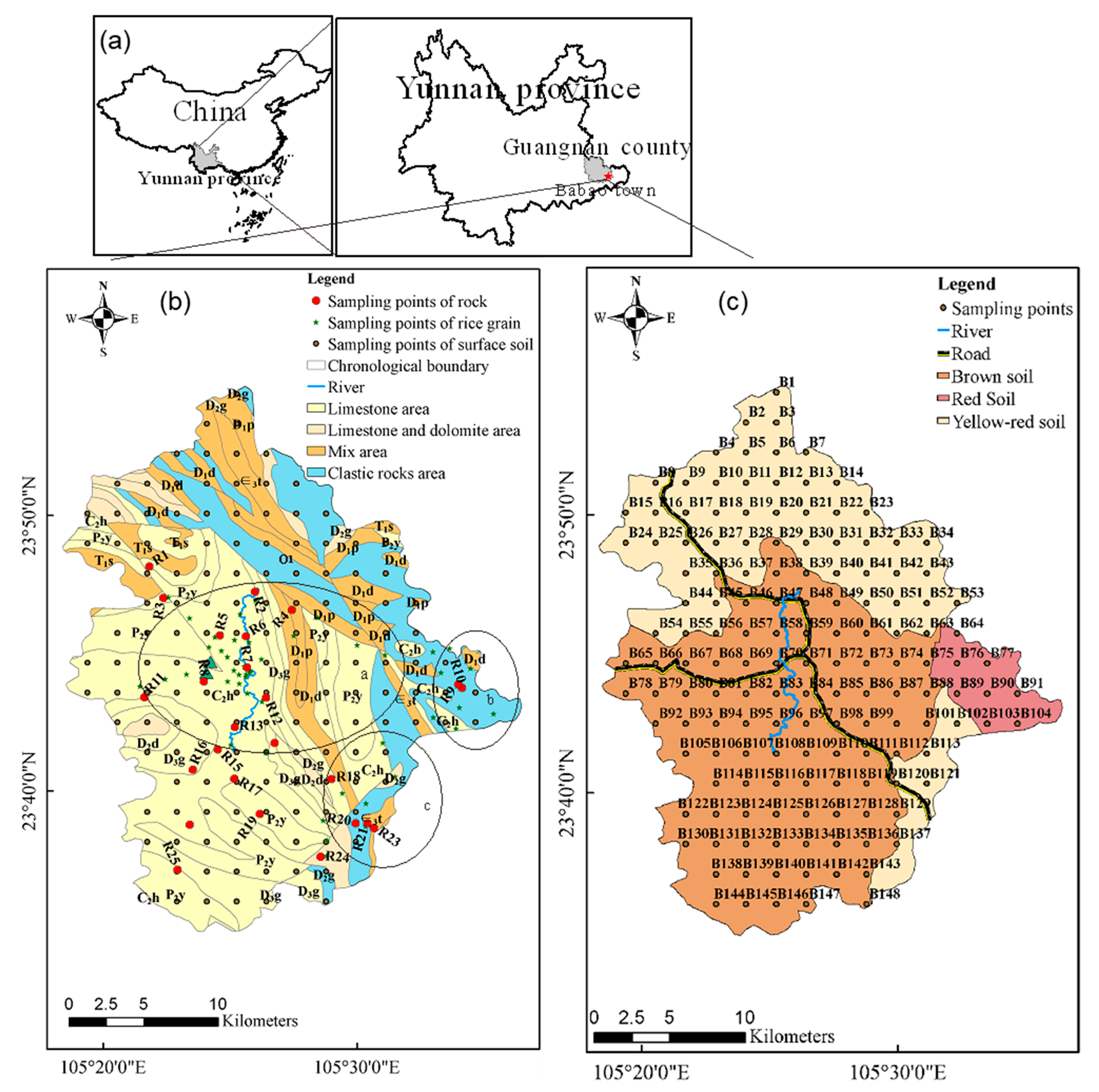
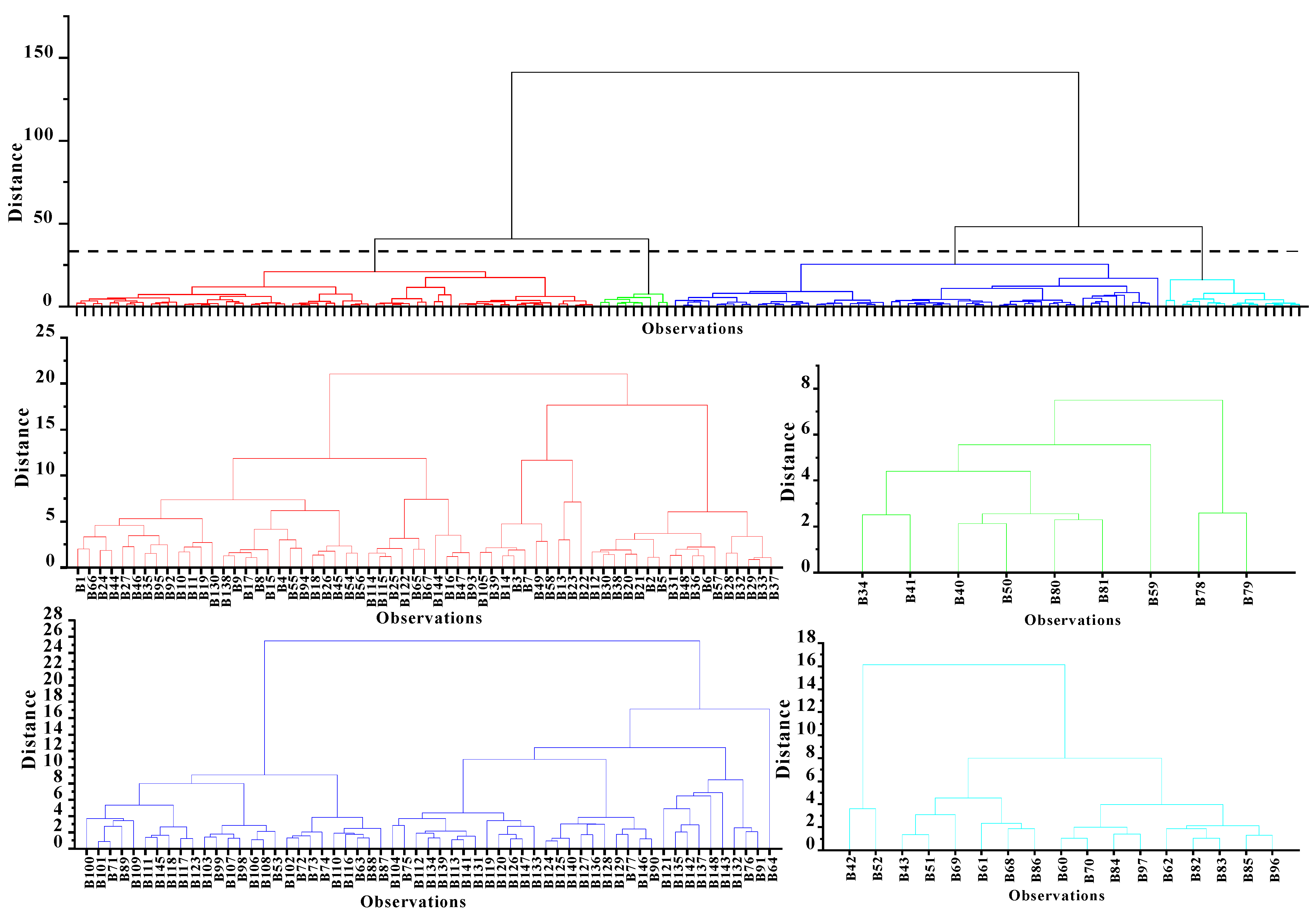


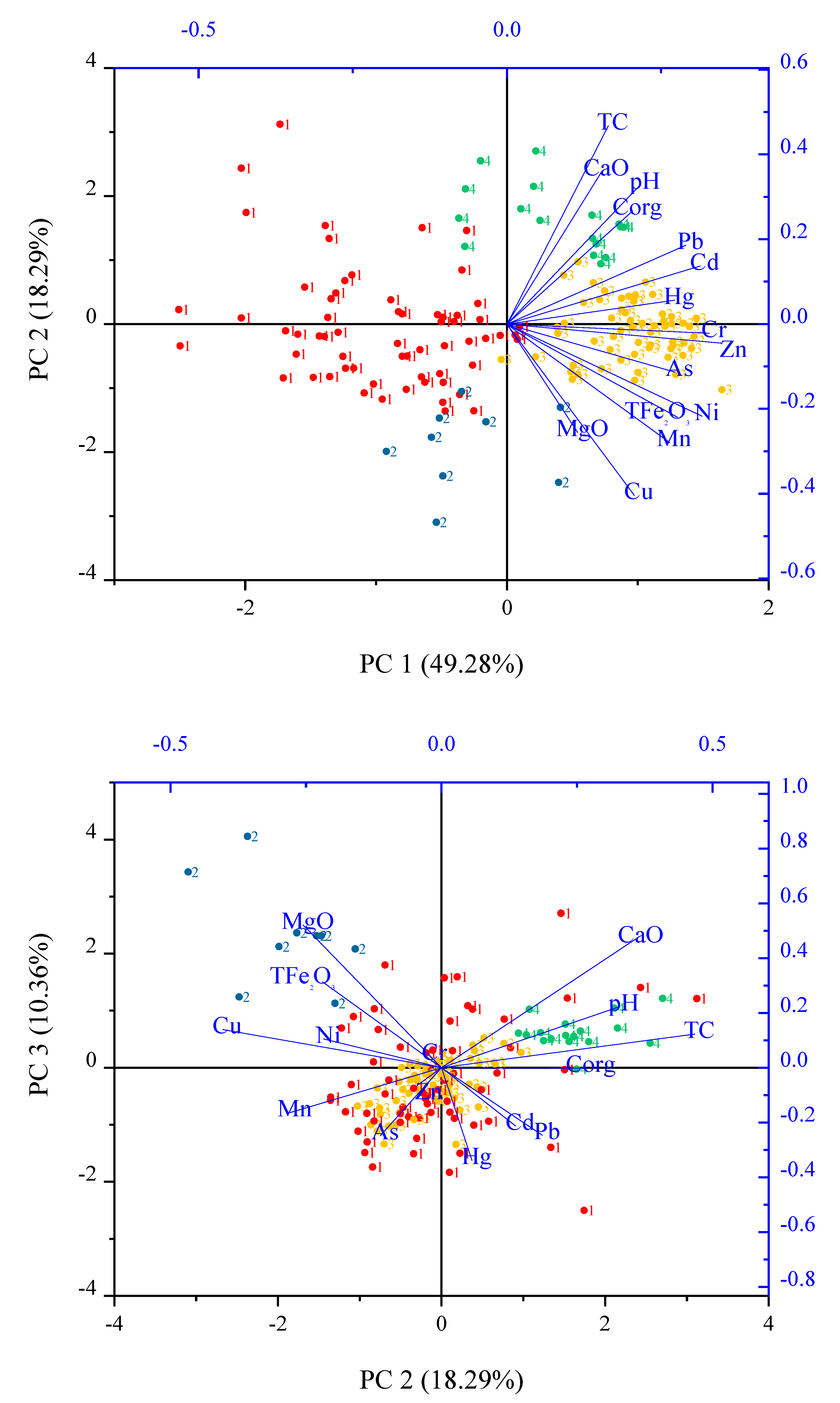
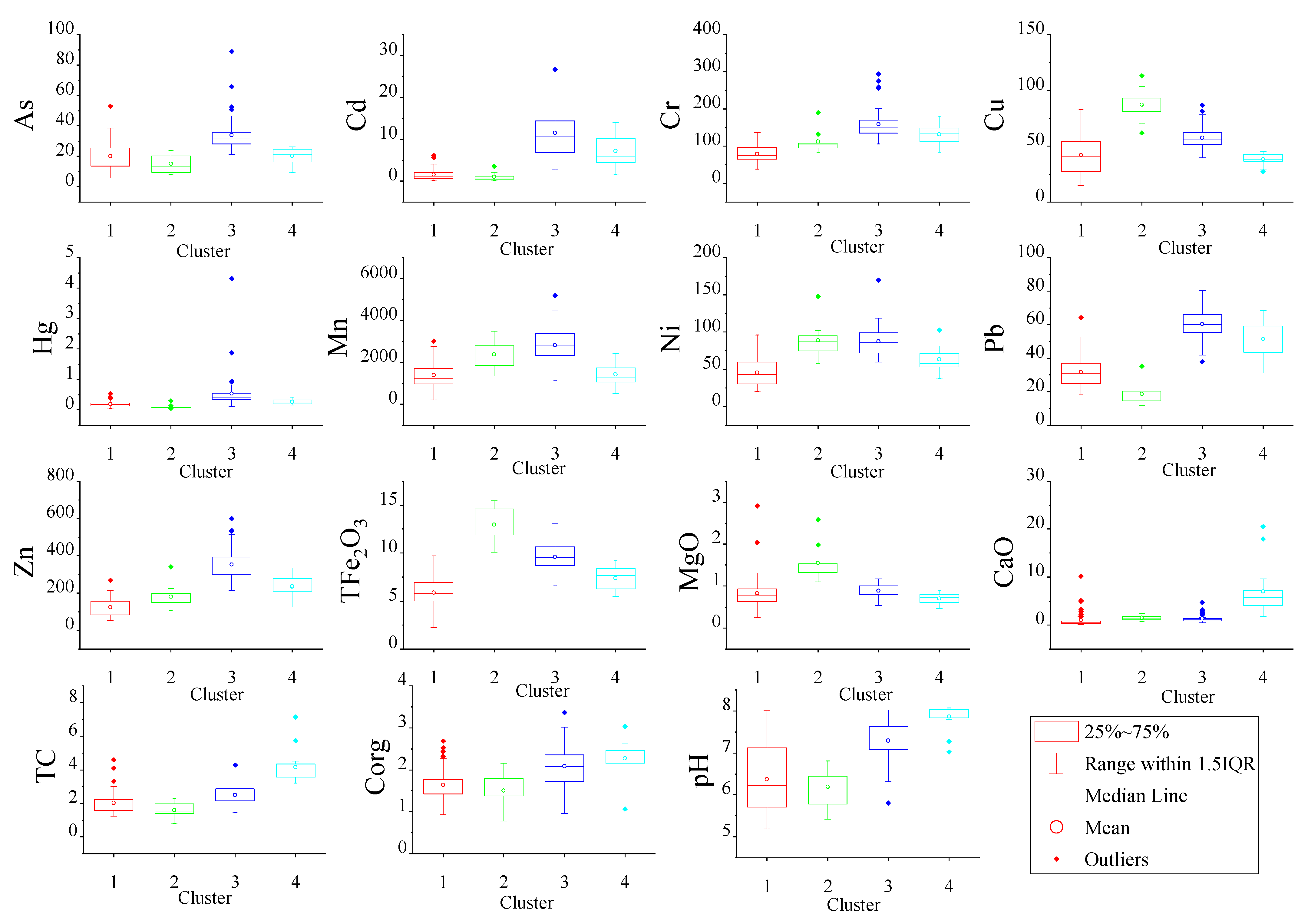
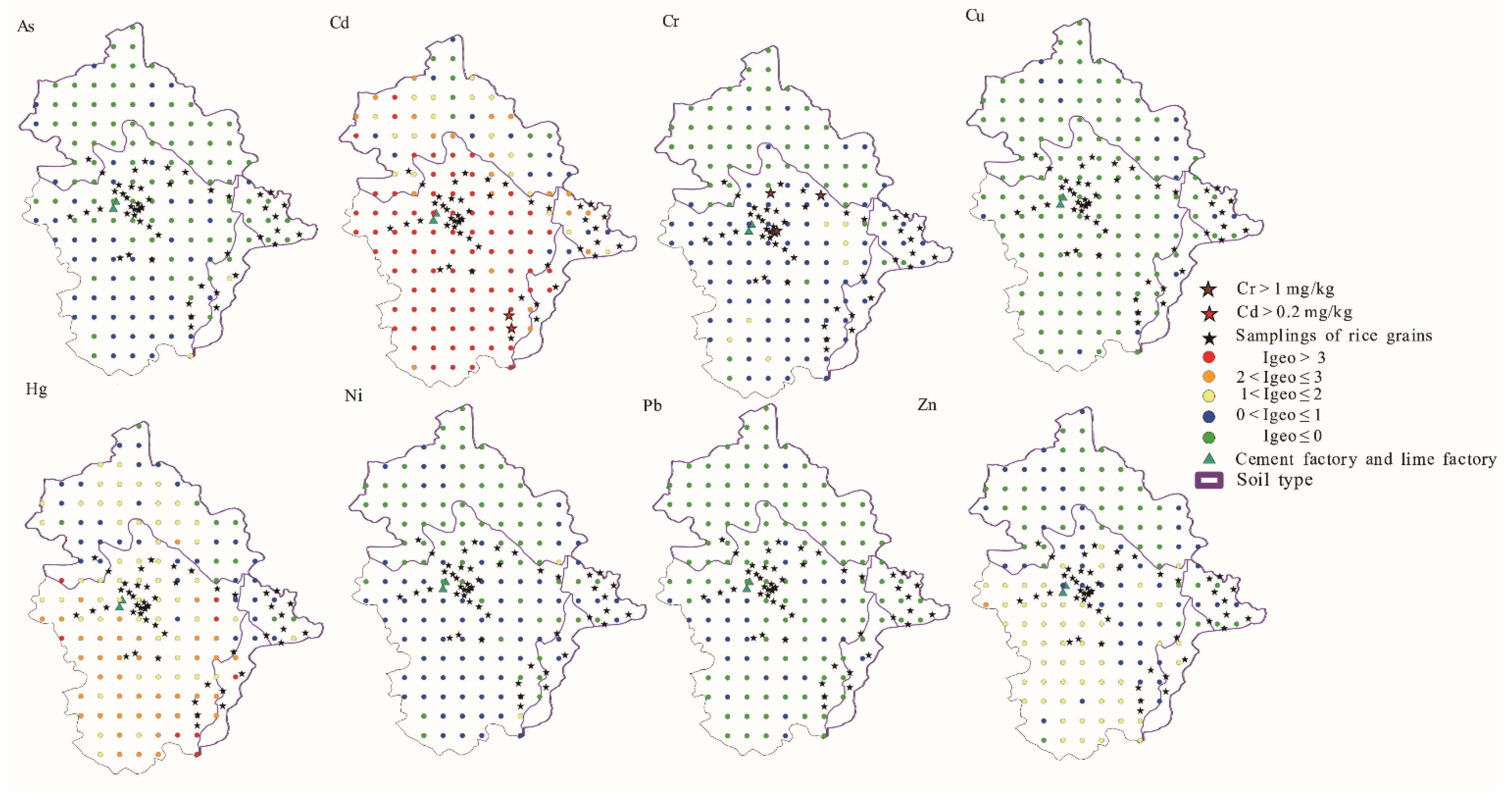
| Samples | Item | As | Cd | Cr | Cu | Hg | Ni | Pb | Zn |
|---|---|---|---|---|---|---|---|---|---|
| Surface soil | Mean | 25.34 | 6.150 | 119.03 | 50.58 | 0.329 | 66.96 | 44.53 | 231.11 |
| SD | 11.48 | 6.086 | 47.06 | 17.68 | 0.396 | 26.82 | 17.38 | 124.22 | |
| CV/% | 45.3 | 99.0 | 39.5 | 35.0 | 120.3 | 40.1 | 39.0 | 53.7 | |
| Median | 24.89 | 4.021 | 115.90 | 51.24 | 0.269 | 68.03 | 44.15 | 214.70 | |
| Range | 5.76–88.94 | 0.167–26.699 | 38.40–293.60 | 14.73–112.95 | 0.051–4.315 | 0.06–169.49 | 11.70–80.50 | 52.40–599.20 | |
| Background of Yunnan [26] | 18.40 | 0.218 | 65.20 | 46.30 | 0.058 | 42.50 | 40.60 | 89.70 | |
| Rice rain | Mean | 0.12 | 0.043 | 0.40 | 1.64 | 0.004 | 0.31 | 0.067 | 17.92 |
| CV/% | 22.6 | 124.2 | 119.8 | 41.6 | 45.9 | 60.8 | 68.1 | 18.5 | |
| SD | 0.19 | 0.440 | 0.03 | 0.68 | 0.52 | 0.001 | 0.02 | 0.02 | |
| Median | 0.12 | 0.026 | 0.11 | 1.64 | 0.003 | 0.36 | 0.06 | 18.79 | |
| Range | 0.04–0.19 | 0.009–0.303 | 0.07–1.92 | ND–3.005 | 0.002–0.010 | 0.06–0.70 | ND–0.281 | 10.94–24.09 | |
| MLC(China a) | - | 0.2 | 1 | 10 | 0.02 | - | 0.2 | 50 | |
| MLC(FAO/WHO) | 0.2/0.35 b | 0.4 b | - | - | - | - | 0.2 b | - | |
| Mn | TFe2O3 | MgO | CaO | TC | Corg | pH | |||
| Surface soil | Mean | 2020.78 | 7.96 | 0.88 | 1.88 | 2.43 | 1.88 | 6.90 | |
| CV/% | 48.0 | 31.3 | 38.5 | 145.6 | 37.9 | 25.8 | 12.1 | ||
| SD | 970.48 | 2.49 | 0.34 | 2.73 | 0.92 | 0.49 | 0.84 | ||
| Median | 1874.00 | 7.89 | 0.83 | 1.05 | 2.26 | 1.80 | 7.12 | ||
| Range | 204.16–5187.00 | 2.23–15.45 | 0.25–2.91 | 0.14–20.48 | 0.81–7.15 | 0.78–3.36 | 5.19–8.07 |
| Item | PC1 | PC2 | PC3 |
|---|---|---|---|
| Percentage of Variance | 49.28% | 18.29% | 10.36% |
| Cumulative Percent | 49.28% | 67.57% | 77.93% |
| As | 0.272 | −0.113 | −0.247 |
| Cd | 0.313 | 0.137 | −0.213 |
| Cr | 0.328 | −0.022 | 0.043 |
| Cu | 0.206 | −0.404 | 0.139 |
| Hg | 0.271 | 0.056 | −0.338 |
| Ni | 0.263 | −0.279 | −0.164 |
| Pb | 0.317 | −0.218 | 0.105 |
| Zn | 0.29 | 0.186 | −0.246 |
| Mn | 0.349 | −0.045 | −0.065 |
| TFe2O3 | 0.276 | −0.22 | 0.313 |
| MgO | 0.115 | −0.255 | 0.521 |
| CaO | 0.154 | 0.359 | 0.471 |
| TC | 0.164 | 0.467 | 0.123 |
| Corg | 0.204 | 0.267 | −0.001 |
| pH | 0.216 | 0.328 | 0.222 |
| Rock Type | Rock Number | Item | As | Cd | Cr | Cu | Hg | Ni | Pb | Zn |
|---|---|---|---|---|---|---|---|---|---|---|
| Carbonate rock | R2–R6, R9, R11–R19, R22, R23 | Mean | 0.55 | 0.69 | 10.55 | 1.68 | 0.014 | 13.15 | 2.65 | 4.21 |
| Median | 0.31 | 0.40 | 10.60 | 1.71 | 0.014 | 13.30 | 2.14 | 3.85 | ||
| Csoil/Crock | 61.19 | 16.56 | 15.07 | 34.24 | 38.05 | 6.64 | 22.76 | 83.53 | ||
| Clastic rock | R1, R7, R8, R10, R20, R21 | Mean | 4.86 | 0.70 | 53.02 | 26.42 | 0.043 | 30.95 | 17.51 | 71.08 |
| Median | 4.68 | 0.14 | 51.65 | 26.70 | 0.027 | 31.90 | 15.55 | 72.05 | ||
| Csoil/Crock | 3.13 | 1.48 | 2.12 | 3.30 | 2.59 | 2.88 | 1.06 | 2.55 |
Publisher’s Note: MDPI stays neutral with regard to jurisdictional claims in published maps and institutional affiliations. |
© 2021 by the authors. Licensee MDPI, Basel, Switzerland. This article is an open access article distributed under the terms and conditions of the Creative Commons Attribution (CC BY) license (http://creativecommons.org/licenses/by/4.0/).
Share and Cite
Tian, H.; Zhang, C.; Qi, S.; Kong, X.; Yue, X. Concentration and Spatial Distribution of Potentially Toxic Elements in Surface Soil of a Peak-Cluster Depression, Babao Town, Yunnan Province, China. Int. J. Environ. Res. Public Health 2021, 18, 3122. https://doi.org/10.3390/ijerph18063122
Tian H, Zhang C, Qi S, Kong X, Yue X. Concentration and Spatial Distribution of Potentially Toxic Elements in Surface Soil of a Peak-Cluster Depression, Babao Town, Yunnan Province, China. International Journal of Environmental Research and Public Health. 2021; 18(6):3122. https://doi.org/10.3390/ijerph18063122
Chicago/Turabian StyleTian, Hongyu, Cheng Zhang, Shihua Qi, Xiangsheng Kong, and Xiangfei Yue. 2021. "Concentration and Spatial Distribution of Potentially Toxic Elements in Surface Soil of a Peak-Cluster Depression, Babao Town, Yunnan Province, China" International Journal of Environmental Research and Public Health 18, no. 6: 3122. https://doi.org/10.3390/ijerph18063122
APA StyleTian, H., Zhang, C., Qi, S., Kong, X., & Yue, X. (2021). Concentration and Spatial Distribution of Potentially Toxic Elements in Surface Soil of a Peak-Cluster Depression, Babao Town, Yunnan Province, China. International Journal of Environmental Research and Public Health, 18(6), 3122. https://doi.org/10.3390/ijerph18063122






